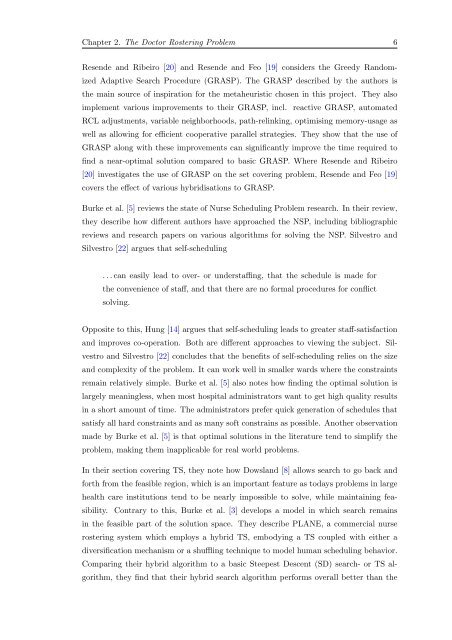The Doctor Rostering Problem - Asser Fahrenholz
The Doctor Rostering Problem - Asser Fahrenholz
The Doctor Rostering Problem - Asser Fahrenholz
Create successful ePaper yourself
Turn your PDF publications into a flip-book with our unique Google optimized e-Paper software.
Chapter 2. <strong>The</strong> <strong>Doctor</strong> <strong>Rostering</strong> <strong>Problem</strong> 6<br />
Resende and Ribeiro [20] and Resende and Feo [19] considers the Greedy Random-<br />
ized Adaptive Search Procedure (GRASP). <strong>The</strong> GRASP described by the authors is<br />
the main source of inspiration for the metaheuristic chosen in this project. <strong>The</strong>y also<br />
implement various improvements to their GRASP, incl. reactive GRASP, automated<br />
RCL adjustments, variable neighborhoods, path-relinking, optimising memory-usage as<br />
well as allowing for efficient cooperative parallel strategies. <strong>The</strong>y show that the use of<br />
GRASP along with these improvements can significantly improve the time required to<br />
find a near-optimal solution compared to basic GRASP. Where Resende and Ribeiro<br />
[20] investigates the use of GRASP on the set covering problem, Resende and Feo [19]<br />
covers the effect of various hybridisations to GRASP.<br />
Burke et al. [5] reviews the state of Nurse Scheduling <strong>Problem</strong> research. In their review,<br />
they describe how different authors have approached the NSP, including bibliographic<br />
reviews and research papers on various algorithms for solving the NSP. Silvestro and<br />
Silvestro [22] argues that self-scheduling<br />
. . . can easily lead to over- or understaffing, that the schedule is made for<br />
the convenience of staff, and that there are no formal procedures for conflict<br />
solving.<br />
Opposite to this, Hung [14] argues that self-scheduling leads to greater staff-satisfaction<br />
and improves co-operation. Both are different approaches to viewing the subject. Sil-<br />
vestro and Silvestro [22] concludes that the benefits of self-scheduling relies on the size<br />
and complexity of the problem. It can work well in smaller wards where the constraints<br />
remain relatively simple. Burke et al. [5] also notes how finding the optimal solution is<br />
largely meaningless, when most hospital administrators want to get high quality results<br />
in a short amount of time. <strong>The</strong> administrators prefer quick generation of schedules that<br />
satisfy all hard constraints and as many soft constrains as possible. Another observation<br />
made by Burke et al. [5] is that optimal solutions in the literature tend to simplify the<br />
problem, making them inapplicable for real world problems.<br />
In their section covering TS, they note how Dowsland [8] allows search to go back and<br />
forth from the feasible region, which is an important feature as todays problems in large<br />
health care institutions tend to be nearly impossible to solve, while maintaining fea-<br />
sibility. Contrary to this, Burke et al. [3] develops a model in which search remains<br />
in the feasible part of the solution space. <strong>The</strong>y describe PLANE, a commercial nurse<br />
rostering system which employs a hybrid TS, embodying a TS coupled with either a<br />
diversification mechanism or a shuffling technique to model human scheduling behavior.<br />
Comparing their hybrid algorithm to a basic Steepest Descent (SD) search- or TS al-<br />
gorithm, they find that their hybrid search algorithm performs overall better than the


